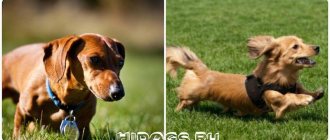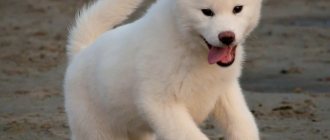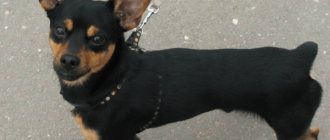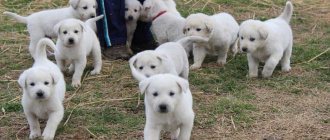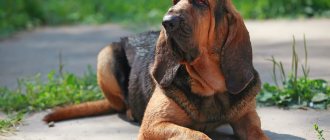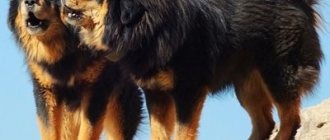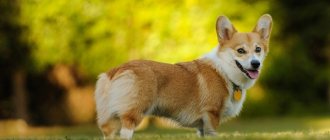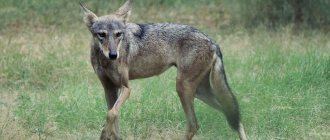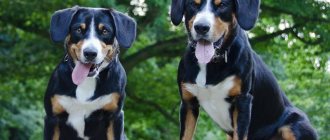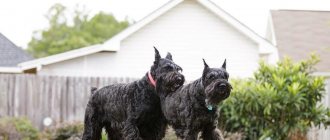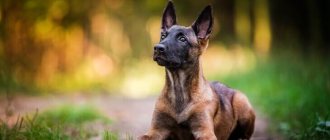Large breeds of dogs often frighten people and inspire awe with their very appearance. But practice shows that usually such pets are quite kind and calm. One of the best representatives of such breeds is the bullmastiff.
There are quite a lot of questions surrounding these dogs, because they look quite serious, not to mention their size, but it is quite easy to find photos of them with children of different ages. Together we will try to figure out what this breed is.
History of the breed
The name "bullmastiff" stands for "large bulldog". This translation is completely true; representatives of this breed are distinguished by their large dimensions and all the features of a bulldog. The first information about the bullmastiff appeared in the second half of the eighteenth century.
These dogs have come a long way before official recognition. It was only in 1924 that the breed was registered and a standard was defined. In June 1925, breed lovers organized the Mindland Bullmastiff Club. Since that time, these dogs quickly began to conquer European and Asian countries, they are admired by Americans and residents of the countries of the former USSR.
The homeland of the bullmastiff is England. This breed was bred specifically to help the guards who fought against poachers. The huge dog had to be able to quickly detect the intruder, catch up and hold it without causing harm until the owner arrived.
In addition, the bullmastiff is silent, giving voice only when necessary. The breeders managed to create a dog that meets all the requirements. As a result, representatives of the breed have proven themselves well not only as guards of forests and other territories, but also as police dogs.
Answers to the main questions
- How are they suitable to be a pet? In the right home and with the right training, the Bullmastiff makes an excellent family dog. Yet its size and protective instinct are not suitable for families with small children. Other people's children visiting your home could be in danger if your dog misunderstands their hectic play. And young (up to three years old) bullmastiffs love to frolic and can knock a child down.
- What type of owner? This is a dog for a strong, calm, confident and experienced owner who has time to train and socialize the puppy and to socialize (the Bullmastiff always craves it). The owner will also have to calmly accept wheezing, snoring, drooling and flatulence.
- How do they get along with other pets? Caution is needed. Adult Bullmastiffs can be aggressive towards other dogs of the same sex, so early socialization is important. These dogs are usually friends with cats if they grew up together, but they should not meet other people's animals. The bullmastiff can simply trample small pets.
- What kind of physical activity is needed? The Bullmastiff will cope with an average load, but it definitely needs daily walks. This breed is prone to laziness, dogs need to be forced to move, otherwise they gain excess weight. Heavy exercise is not recommended for puppies under two years of age, so as not to damage their growing bones.
- What type of house? Large dogs need space, and this breed is not suitable for a small home. The ideal option is a large country house with a garden and a secure fence (a bullmastiff can knock over a light fence if it wants). The breed does not tolerate extreme temperatures well, so the dog must have a cool place to hide in extreme heat.
- What are good qualities? Fearless, powerful, loyal, good guard, sensitive but calm, cheerful, active, reliable, patient, persistent.
- How easy is it to train them? Moderately difficult. A strong, stubborn bullmastiff needs to be convinced that he is not the head of the family. Training should start early, be firm, patient and consistent, and keep sessions short and fun. Tactics of pressure and threats will lead nowhere here. This is a guard breed, and puppy socialization is essential if you want your Bullmastiff to allow visitors into your home in the future. For such a large dog, training is also necessary.
- What should we be afraid of? The breed is not for beginners. Although adult Bullmastiffs are usually calm and intelligent, puppies can be difficult. Guarding instincts mean that dogs without proper socialization and training can become a source of trouble for their owners.
Breed standard
The Bullmastiff is a powerful dog with a harmonious build. She has great strength, but is agile, energetic, and able to quickly develop speed. The weight of adults is 41-59 kg , height is about 61-68 cm , females are noticeably smaller in size than males, they are lighter and shorter in stature.
The arched neck is of medium length, muscular, comparable in circumference to the skull. The head is square, heavy, and the skull is wide. If the dog is preoccupied with something, numerous wrinkles appear on the head, but in a calm state they are not noticeable. The ears are set wide apart, small in size, close to the head. The color is darker than the color of the body. According to the standard, rose-shaped ears with folds are unacceptable. There is a small indentation between the dark eyes. Light eye color is considered a defect.
The muzzle is short, wide, and square in shape. The cheeks are full, the nose is rounded, wide, the nostrils are wide open. The jaws are powerful, the fangs are large and strong. A straight bite is preferred, but a slight overbite is acceptable.
The physique is powerful, compact, the back is straight and short. A sagging back is considered a fault. The sides are deep, the loin is wide. The chest is also wide and deep. Legs are strong, with well-developed muscles, straight. The paws are cat-like, the paw pads are hard, the claws are dark. The movements are balanced, defined, strong. The tail is straight or slightly curved upward.
The coat is short, smooth, and lies close to the body. The hair feels hard to the touch. The following coat colors are allowed:
1. Coffee with milk. 2. Tiger. 3. Fawn. 4. Red. 5. Red.
A black mask is required on the face, a small white mark is allowed on the chest, and a dark edging around the eyes.
Description and photo
The Bullmastiff is a fairly large breed and is bred as a companion and protector. This breed is controversial - behind its stern appearance lies an easy-going character.
The characteristics of the Bullmastiff breed are as follows:
- Males weigh 60 kg. The female's body weight varies from 45 to 54 kg.
- The dogs are large. The size of an adult male at the withers is 70 cm, females - 66 cm maximum.
- Harmonious physique.
- The back is straight and short.
- The forelimbs are widely spaced, the hind limbs are much stronger, clearly defined muscles.
- The paws have hard pads and the claws have a dark tint.
- The dogs move harmoniously and smoothly.
- The chest is wide, strongly lowered between the front legs.
- The muzzle is short and rectangular in shape.
- Large fangs, widely spaced.
- The ears are wide, set high, hanging.
- Eyes are medium size, dark.
According to generally accepted standards, regardless of coat color, white spots are allowed in the chest area.
Size and appearance
The bullmastiff's appearance is similar to its American ancestor. The size and character of the dog have undergone changes. The dogs are large: males grow up to 70 cm at the withers and weigh about 60 kg. Females are smaller - weight 50 kg and height 65 cm.
The animals have short but thick fur. According to the description and standards, there are 4 variations of wool shade:
- Sand is the most popular color.
- Red - takes second place in the rating.
- Deer is a rare color.
- Brindle - in the Middle Ages was considered the most successful coat color, because the dog easily hid in the thickets.
Surprisingly, black is a popular color among purebred bulldogs. However, by standards, black bullmastiffs are unacceptable.
Lifespan
Bullmastiffs, like many other large dogs, do not live long lives. If quality care is provided, the average duration will be 10 years. Such a short period is determined by a number of genetic diseases.
Character
The Bullmastiff breed is valued by many for its poise, affection, and kindness towards household members and others. The appearance of the animal is quite aggressive and threatening. But the dog is easy to train and educate. Representatives of this breed remember the roots of their origin, therefore they show humility, but do not allow themselves to be treated inappropriately.
A significant character flaw is vindictiveness, stubbornness, and some aggression. If you behave incorrectly with a dog and undeservedly offend it, the consequences will be disastrous. If a dog at least once in his life feels that he dominates you, then his arrogance and stubbornness will know no bounds.
Attitude towards others
It is important to remember the history of the origin of this dog and the fact that dogs were regularly used to fight bulls, bears and other animals. For this reason, bullmastiffs do not have a special love for other animals, including small ones. However, if there is a cat in the house with which the puppy lived from a young age, then it will be under reliable protection, because the dog will take the cat under protection.
Attitude towards children
Animals treat small children with special care; dogs spend most of their time in active games. With age, the attitude towards children does not change, however, dogs take part in games less and less. When interacting with children, the dog always restrains himself and learns to endure. But when the bullmastiff is left alone, he tries to retire. Aggression and irritability are not visible from them.
Intelligence
Dogs' intelligence is well developed. Thanks to this, they are able to adapt to each family member. Show aggression and strength in emergency situations. The rest of the time they are affectionate and friendly.
Maintenance and care
Despite its large dimensions, the Bullmastiff can easily live in an apartment. Of course, the owners will experience some feeling of cramped space, but this pet never gets underfoot. He can lie for hours, sitting on his favorite rug.
The dog does not need special, increased physical activity. This does not mean that he does not need to be walked. Twice a day, preferably in the morning and evening, the owner should take the dog for a walk. At the same time, it is under no circumstances acceptable to allow her to walk freely in crowded places without a leash and without a muzzle.
If you decide to keep a bullmastiff in an enclosure, it should be spacious with a large, insulated booth. When letting him walk in private territory, the owner first checks the reliability of the fence so that the dog cannot independently go beyond the borders of his property.
From the first days of being in the house, the dog should know its place, have a bed, bowls for water and food, and toys. It is forbidden to play tug with a puppy that is not yet strong enough, using, for example, a rag or a toy bone. As a result of such entertainment, the pet’s still unformed bite may deteriorate.
In order for a dog to grow healthy and beautiful, it is necessary to properly care for it. The procedures for caring for a bullmastiff are quite simple and take little time:
- For short hair, brushing twice a week is sufficient. Thanks to this, dead hairs are removed, the coat becomes shiny, and the dog looks well-groomed.
- It is recommended to bathe 1-2 times a year, not more often.
- Once a week, clean your ears with a cotton swab and inspect them for inflammation or damage.
- Trim nails as they grow.
- The bullmastiff's eyes must be monitored daily; they are considered the animal's weak point. The fact is that his eyelids do not protect the mucous membrane from pollution. As a result of exposure to even ordinary dust, various eye diseases often develop. Therefore, if you notice redness or excessive discharge, take your pet to a veterinarian.
- Another not very pleasant moment in caring for a bullmastiff is increased salivation. There is no use fighting him. The owner can only stock up on towels and wipe the dog’s face more often. It is worth noting that drooling is especially strong when the dog eats, drinks water or physically exerts itself.
- To clean your teeth, it is better to purchase special bones, although you can clean them with a special paste and brush.
Feeding such a large dog is not easy. In order to properly formulate a diet, it is recommended to seek advice from a veterinarian. The menu for a bullmastiff must be carefully prepared so that the body receives all the necessary foods, vitamins and minerals. As a result of improper nutrition, the puppy’s bones will not form correctly.
It is recommended to feed representatives of the breed with natural food, although dry food is also not prohibited. Products with collagen must be present in your diet. They help strengthen bones by supplying the body with phosphorus and calcium. 70% of the diet is protein food. It is also important that the dog always has access to cool, clean water.
What to feed a bullmastiff?
The diet for a bullmastiff must be carefully selected and formulated. Due to the fact that this is a huge breed, some difficulties may arise. From an early age, you need to ensure that the puppy grows proportionally and that the bones and tendons are properly strengthened.
You should definitely include foods that contain collagen in your food. Its use strengthens bones by saturating the dog’s body with calcium and phosphorus. Collagen or gelatin can be given in special supplements or prepared independently. For this you will need beef or pork joints. The recipe is simple - pour them with a small amount of water and simmer for a long time.
Ideally, bullmastiffs should be fed natural, high-quality products. Dry ball will save a lot of time and labor, but this option is not the best, although it is popular. Dogs that eat natural food are much more active, resilient and energetic than their fellow dogs who grew up on artificial, albeit balanced food.
Any meat, fish without small bones, various vegetables, cereals and dairy products are the main food of bullmastiffs. They eat them well both raw and boiled. It will be useful to treat these dogs with one chicken egg two or three times a week.
The intelligence of Bullmastiffs is perfectly combined with courage, endurance, courage, energy, loyalty and strength. Despite some slowness, they are excellent watchdogs with excellent and lightning-fast reactions. Under their protection, it is very comfortable and safe for both adult household members and small children. By choosing this breed of dog and making every effort to educate them, every owner will be satisfied. Natural inclinations and the firm hand of the owner will create a faithful friend.
Health
Bullmastiffs are naturally hardy and healthy dogs with a strong immune system. With proper care and maintenance, such a dog can live about 9-10 years, and there are twelve-year-old centenarians. The owner of a bullmastiff should know what diseases the pet is predisposed to:
- Oncological diseases.
- Skin diseases.
- Lameness.
- Joint dysplasia.
- Entropy - incorrect position of the eyelids can only be eliminated surgically.
- Anterior cruciate ligament rupture is a pathology of the knee joint.
- Hypothyroidism is a lack of thyroid hormones.
- Cystinuria – cystine kidney stones.
- Gastrointestinal diseases - bloating, volvulus, diarrhea, dilation of the stomach.
- Obstructive cardiomyopathy is a serious disease of the cardiovascular system.
How to choose a puppy and how much will you have to pay for it?
When choosing a puppy, special attention should be paid to the purity of the breed, since purebred pets are almost guaranteed to have all those qualities valued in bullmastiffs: non-conflict, good trainability, attachment to the family, etc. The best option is to purchase a puppy from a trusted breeder, who can be found through a kennel club or in a kennel. When purchasing a puppy from a breeder, it is a good idea to have it examined by a veterinarian. The condition of the puppy's heart and joints is checked.
It is quite possible that contacts with the breeder will last for several more years, because caring for and raising such a breed can be difficult for beginners, so this must be taken into account when selecting a breeder. The cost of a puppy greatly depends on the exterior class assigned to it - pet (lower class with some deviations from the standard), breed (meeting breed standards) or show (highest class, whose representatives win in exhibitions). The price of a Bullmastiff can range from $250 to $5,000 .
Character
With proper and timely socialization, the Bullmastiff is quite adequate and not aggressive. Representatives of the breed exhibit aggression and anger only in justified situations. Such a pet is infinitely devoted to its owner; whenever possible, it always tries to be close to him, and it is difficult for him to experience separation. It is important to instill in the puppy your primacy and dominance from the first day.
The dog behaves friendly with other household members and family friends. Gets along great with children. Despite the love for children, you should not leave a bullmastiff and a child alone. The dog will not intentionally harm the baby, but he may unintentionally push or knock him down during play. He behaves strictly and warily with strangers. He warns the stranger with a quiet growl, thereby showing that he will not tolerate liberties on his part. Barks only in the most extreme cases, it is in the blood.
The bullmastiff's hunting instinct is so developed that it is better not to leave such a dog alone with domestic animals, especially small ones. Cats and dogs are no exception, not to mention rabbits and birds. The dog may mistake them for prey and start hunting. To avoid such problems, it is necessary to properly raise and socialize the dog.
The Bullmastiff always strives for dominance. It is especially difficult with males; they do not tolerate competition. It is not recommended to keep two males of this breed together, even if you raise them from puppyhood.
Application
Initially remaining a guard dog, the Bullmastiff can become an excellent companion and affectionate pet.
You can learn about other breeds of guard dogs from the article
In a country house, he will successfully cope with the duties of a reliable security guard, like a Tosa Inu or a Kangal , preventing an attempt to enter your territory, and will receive good physical exercise.
Baby sharpens his teeth
Training and education
Despite its large size and intimidating appearance, the Bullmastiff is one of the best family dogs. The main thing is to raise him correctly from an early age and teach him obedience and rules of behavior, both at home and in public places.
Representatives of this breed are easy to train, as they are intelligent and quick-witted. But during training, it is necessary to take into account the fact that this dog is quite capricious, sometimes very stubborn. Such qualities are inherent in all Molossians. You need to find an approach to your pet, but not with the help of screams and corporal punishment. In this case, the owner of the bullmastiff needs calmness, perseverance, and consistency. It is recommended to use play techniques during training, as well as listen to the advice of an experienced dog handler.
Regarding the training of the bullmastiff, it is worth noting that from birth he has excellent security and guard qualities. They are genetically laid down during the formation of the breed. Based on this, there is no need to develop excessive aggression in such a dog and encourage anger. Only after completing an obedience course and reaching 1.5 years of age, the bullmastiff’s psyche is ready to develop the qualities of a guard.
Interesting Facts
- The original purpose of bullmastiffs was to fight poachers. The dog’s duties were to detect an intruder in the forest, detain him and hand him over to the huntsmen. The bullmastiff was ideal for such service; he is strong, silent, and fearless. Having overtaken the poacher, the dog silently, with a powerful throw, knocked him down without causing injury, then barked to call his owner.
- At the very beginning of history, the British called the bullmastiff “the night dog of the huntsmen.”
- The English football team Arsenal adopted a bullmastiff named Gunner as their mascot. Before each match, the mighty dog walked importantly across the field in front of the spectators, thereby setting up the players for victory.
- Representatives of the breed have a high pain threshold; they are able to patiently endure even very severe pain.
- In the Republic of South Africa, bullmastiffs are used as guard dogs in diamond mines.
Origin history and interesting facts
A bright representative of the bullmastiff breed
The bullmastiff (mastiff) is the oldest breed. It was successfully bred in ancient Persia and Macedonia. They hunted large animals with dogs, such as wild boars, tigers, lions, and used them in gladiator fights. In turn, English dogs descended from Babylonian mastiffs, which were brought to Britain by Phoenician trading people.
There are historical data indicating that up to 50 thousand warriors of this breed served in the army of Alexander the Great, who forced entire enemy armies to flee. They made a significant contribution to the conquest of Persia in the 5th century BC. Thanks to the dogs, the Macedonian began to be called the king of Asia.
Interesting! Mastiffs also accompanied the Roman military leader Gaius Julius Caesar on military campaigns. They subsequently fought wild animals in city arenas, entertaining the Roman public.
After the collapse of the Roman Empire, Babylonian mastiffs spread throughout Europe and became the progenitors of many new breeds. Dogs began to be used everywhere to protect the vast lands of the nobility from the invasion of poachers exterminating game. The black bullmastiff was considered the best for performing night duty to protect game, as it is more inconspicuous in the dark.
From these huge dogs, by crossing with the Old English Bulldog in the 19th century, a new breed of Molosser was bred, possessing the power and size of its ancestors, but more docile. Queen Elizabeth I, who became famous for her love of dog fights, contributed to the breeding of bullmastiffs.
Powerful and serious dogs
During the First and Second World Wars, the number of the Bullmastiff dog breed declined sharply. They were exterminated en masse because they could not feed them. When they tried to restore the breed in peacetime, they managed to find only a dozen individuals, among them there was a single female of childbearing age.
Several more females capable of reproducing offspring were found in Canada and America. Painstaking work began to recreate the breed. Due to the small number of dogs, closely related mating of animals occurred. From here a number of genetic diseases emerged, which were partially eliminated as a result of the painstaking work of breeders.
Although dogs from Canada and the USA contributed to the restoration of the mastiff population, such a breed as the American Bullmastiff does not exist in nature. There is an American pit bull terrier, which still does not have registration from the International Federation of Cynologists and is prohibited for breeding in most EU countries.
Interesting fact! Gunner the bullmastiff, donated to the English football team Arsenal, was their mascot for many years. Every time he entered the field before the game, his appearance demonstrated the power of the team.
Pros and cons of the breed
A dog as large and serious as a bullmastiff is not suitable for every person. You need to have fortitude, skills in handling watchdogs and the ability to keep your pet in proper conditions. Once you familiarize yourself with the main pros and cons of the breed, you can make the right decision.
Advantages:
1. Devotion. 2. Excellent guard qualities. 3. Gets along well with children. 4. Does not require daily physical activity. 5. Despite its large dimensions, it is suitable for keeping in an apartment. 6. Easy care. 7. Rarely barks.
Characteristics, abilities, skills
This is a brave, confident and calm dog. Despite its impressive size, it will never bark or rush at people without reason. If the owner encounters an ill-wisher, it will not seem bad to him.
Bullmastiff: the characteristics of the breed include constant concern for the safety of the owner. His goal is to ward off the threat, and if a fight is inevitable, the dog knocks the enemy down and holds him with all his weight until the owner’s command.
This breed prefers to act, so it rarely speaks. However, the characteristic bark of a bullmastiff cannot be confused with anything; it can only be compared with the roar of a lion.
In the family they are affectionate and devoted. Agile and agile, they love to play and hunt in nature. After an active walk, bullmastiffs usually go to bed. Socialize your dog from a very young age. Then her behavior will be dictated solely by your mood.
By the way, they get along well with children and even become affectionate nannies for the little ones.
The Bullmastiff is indifferent to cats and birds. But he is often aggressive towards members of his own sex, so you should not bring him into a family that already has a dog.
When walking, keep your pet on a leash to avoid an inevitable fight with him.
Bullmastiff: The characteristic of gentle giants does not allow kenneling. They absolutely cannot stand loneliness.
This dog requires long, regular walks. Naturally intelligent and capable, the dog is easy to train. In his upbringing it is necessary to show firmness and determination, and not rigidity. Never undermine your dog's self-esteem.
You need to raise a puppy from a very early age.
Don't let him attack family members and bite. If the puppy is aggressive, grab him by the collar and press him to the ground until the little robber shows his awareness of his guilt.
Dossier
Adult height: males 65-70 cm, females 65-66 cm. Weight: males 55-59 kg, females 50-52 kg. Characteristic colors: sand, red, fawn, brindle. Coat length: short and dense. Life expectancy: 8-10 years. Advantages of the breed: easy to train. Difficulties of the breed: stubborn and vindictive breed. Average price: $500-1000. Classification: large, guard breed.
Bullmastiff puppies cost
On average, the price of such a dog varies from 10,000 to 40,000 thousand rubles, it all depends on where the bullmastiff puppies were purchased. You can buy it second-hand, without a pedigree, for less than 10,000 thousand rubles. If a dog is chosen for protection, then it is better to give preference to specialized kennels. To avoid further problems, when purchasing, you should study all documents: from pedigree to medical certificates.
The Bullmastiff is one of the calmest, most intelligent dogs, which, with proper training, will become not only an excellent bodyguard and security guard, but also an irreplaceable friend. The main thing to remember is that dogs also have their own individuality, so each of them requires a special approach.
Share on social media networks
